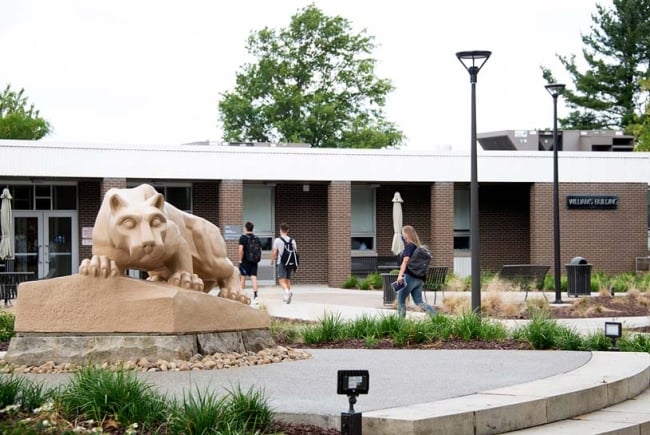You have /5 articles left.
Sign up for a free account or log in.

Penn State is asking lawmakers for $115 million more next year, a nearly 48 percent increase to general fund appropriations.
Twitter/Penn State
State support for higher education has been on the decline in Pennsylvania for years. But Pennsylvania State University leaders are now asking lawmakers to reverse course and significantly invest in higher education in next year’s state budget.
The Penn State Board of Trustees approved a request Friday that will ask the state to increase appropriations to PSU’s general fund next year by roughly 48 percent, or $115.2 million. While the 47.8 percent increase may seem like a striking number, Penn State officials say an internal analysis shows that PSU has long been underfunded compared to other state universities. Officials say the increase is needed to reach the funding level of the next-lowest-funded university.
With the budget-making process well into the distance of next year and the request unlikely to be considered before the early months of 2023, lawmakers aren’t saying much about the request publicly. But outside observers suggest that financial and political realities make a major funding windfall unlikely in a state that has not shown strong financial support for higher education.
Funding Disparities
Penn State receives about $5,600 in state funding for each resident undergraduate student, according to a university analysis. Comparatively, Temple University receives $8,275 per resident undergraduate student, and the University of Pittsburgh receives $9,049 per in-state undergraduate. Penn State officials say those numbers indicate that the university needs more funding.
“We looked at this the way we think a state legislator would look at it,” said Zack Moore, vice president for government and community relations at Penn State. “We believe that legislators, when they fund public higher ed, that they’re funding undergraduate education for in-state residents. That’s what they think of when they’re funding Penn State. Penn State receives $5,600 per student. And every other public university in the commonwealth received significantly more.”
Moore says the disparate funding issue is one that President Neeli Bendapudi, who started in May, was struck by and wanted to focus on as the university prepared its appropriations request.
“When we presented this analysis and this data to our new president, she really latched on to it and, I think, was surprised by it and decided that we should build our appropriations request around gaining equity with at least the next-lowest public university,” Moore said.
He describes the funding issue as “a problem that’s probably 50 years in the making.” Moore notes that Pitt and Temple both became public institutions in the 1960s. Initially, he said, Pitt and Temple received funding at a per-student level similar to Penn State, but as enrollment boomed at PSU, but not necessarily at the others, a disparity grew over a matter of decades.
And in recent years, Pennsylvania lawmakers have offered little help to the state’s public universities. In various analyses, Pennsylvania is regularly near the bottom for higher education appropriations per full-time undergraduate student. For example, a report from the State Higher Education Executive Officers Association found that the national average per full-time enrollment was $9,327 in 2021, whereas in Pennsylvania that number landed at $6,171.
The numbers have been trending downward for years. In 1980, the earliest year for which data are available in SHEEO’s analysis, Pennsylvania was slightly above average for education appropriations per full-time enrollment, Sophia Laderman, an associate vice president at SHEEO, explained by email, noting that this includes state funding and financial aid.
“Since 1980, inflation-adjusted funding per [full-time enrollment] has increased 3% nationally, but has declined 38% in Pennsylvania. As a result, in fiscal year 2021 Pennsylvania’s public institutions received 65% of the average national per-student appropriations—this comes out to $3,230 less in state funding per student than average,” she said. “The decline in state funding in Pennsylvania has occurred in the last two decades. At the turn of the century, Pennsylvania’s state funding was still very close to what it was in 1980. But after the tech bust, funding declined by about $2,400 per student. It then never improved (while in other states, recessionary declines did improve). After the Great Recession in 2008, funding fell another $2,800 through 2017. There have been increases in the last four years (2018 through 2021), but those funding increases have still left Pennsylvania’s average funding per student 39% below what it was two decades ago in 2000.”
Financial and Political Realities
Based on its analysis, Penn State seems to have a case for increasing its state appropriations. But the challenge in getting to parity with other universities will require more than a sound analysis, given the financial and political hurdles that may thwart the appropriations request.
Robert Kelchen, professor and head of the department of educational leadership and policy studies at the University of Tennessee at Knoxville, said the request seems unlikely to pass.
“Last year, it may have been more realistic,” Kelchen explained. “But with rising inflation and concerns about finances, state budgets may not have as much money for next year. And then also, there’s the political aspect of this. Every other institution in Pennsylvania is probably going to follow by requesting more because of their individual needs.”
He also noted that hostility toward higher education may be another challenge to overcome.
“Higher education is just getting politicized in more states, and Pennsylvania is one of them,” Kelchen said.
Of eight lawmakers contacted in the Pennsylvania State Senate and House of Representatives serving on both the appropriations and education committees, only one provided a response.
“We need a wide-ranging and honest discussion of all needs across Pennsylvania during the budget process, so we appreciate Penn State’s candor,” Matthew Bradford, Democratic vice chair on the House Appropriations Committee, said in a statement, which noted Pennsylvania’s low education appropriations. “If the General Assembly is serious about making college more affordable and addressing student indebtedness, we must have a real conversation about the state’s role in funding our institutions of higher education and this is a strong first step.”
Moore said Penn State officials recognize this appropriations request is “a big ask.” But if approved, he said the university will freeze tuition for all resident undergraduates next year. Additional funding will also help Penn State navigate budget challenges exacerbated by inflation.
“Penn State has been operating at a sub-inflationary level for the last decade in terms of both appropriations and tuition, even with the tuition increase we instituted in the current academic year. We have not kept up with inflation in either appropriations or tuition for last decade. When you layer COVID-19 expenses and lost revenues on top of that, we’ve got a bit of a budget challenge on our hands here. So it will help us quite a bit to address those budget challenges,” Moore said.
Though Kelchen is skeptical lawmakers with competing priorities will sign off on Penn State’s appropriations request in the next legislative session, he said the move sends a message. Externally, Penn State is making the case to lawmakers that it needs more support. Internally, the university is signaling to students and employees that it is trying to support them.
The appropriations request is “a combination of a protest and a plea for help,” Kelchen said.
How lawmakers react to the request remains to be seen, but Moore said that he believes it is critical to have this conversation with elected officials, even if it takes time to see progress.
“Our intent is not just to increase our funding, but also to raise awareness with our elected officials about how they fund higher education, to start a conversation with them about correcting this inequity. Whether we correct this in one year or it takes more than one year, that’s OK, as long as we move in the right direction. I think in the long run, it will benefit Penn State University, Penn State students and Penn State employees if we can get there,” Moore said.




